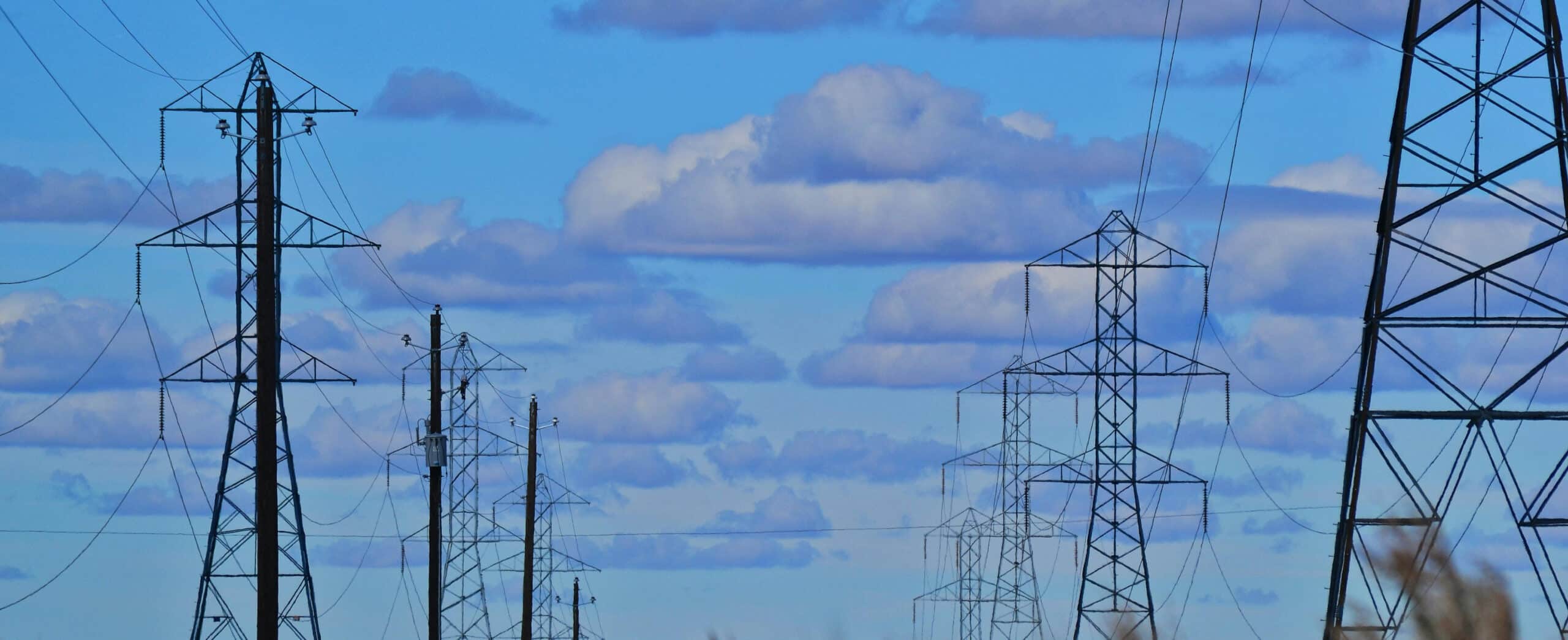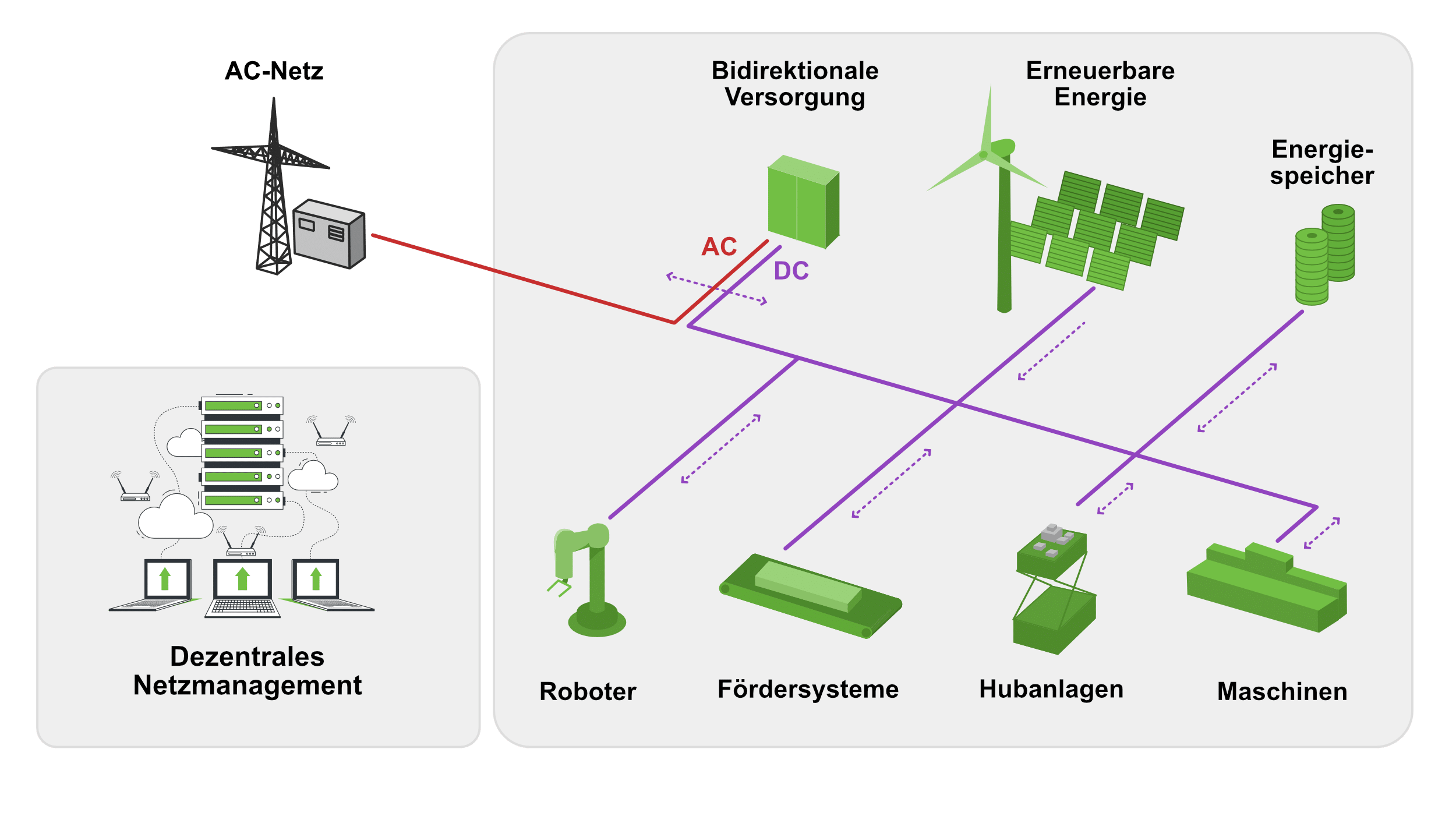
Direct current (DC) and alternating current (AC) are the two basic forms of electric current. While direct current (DC) maintains a constant direction and voltage, alternating current (AC) periodically changes its direction and voltage.
Traditionally, alternating current comes out of our sockets, which moves up and down in a sinusoidal pattern and changes polarity 100 times per second. This form of current has prevailed due to historical development, but for many modern electrical devices a direct voltage would be more suitable. These devices, such as computers, televisions and many other electronic devices, must first convert the alternating current from the socket into direct current. This requires additional power supplies that consume energy and generate heat, resulting in a loss of efficiency.

Switching to a direct current grid has the potential to generate significant energy savings. Studies and practical applications show that such a grid can save between five and ten percent of energy. These savings are particularly important in the context of global efforts to reduce energy consumption and CO2 emissions.
One of the main sources of energy loss in conventional power grids is the conversion of alternating current (AC) into direct current (DC). Alternating current flows in our sockets, while many modern appliances, from smartphones and washing machines to electric cars, require direct current. The conversion from alternating current to direct current leads to energy losses of around 20 percent for some devices. A direct DC supply can significantly reduce these losses, increasing the overall efficiency of the power grid.
Another advantage of direct current technology is the efficient use of recuperation energy. In industrial applications, such as high-bay racking systems and industrial robots, excess kinetic energy can be recovered and reused. This contributes significantly to energy savings. In addition, direct current enables energy to be stored directly and efficiently in batteries without additional conversion losses. This is particularly relevant for data centers, production facilities and electromobility, for which a continuous and reliable power supply is crucial.
Direct current grids require cables with a smaller cross-section compared to alternating current grids. This leads to significant savings in materials and resources, which not only reduces costs but also contributes to sustainability. Direct current offers an exciting alternative, particularly in new buildings or production facilities where photovoltaic systems and battery storage are used. Here, the planning freedom can be used to align the infrastructure to direct current from the outset and thus maximize efficiency.
One notable example of the successful implementation of a direct current network is the production facility at the BMW plant in Dingolfing. Since 2016, BMW has been using direct current technology in a production cell to increase energy efficiency. By using recuperation energy within the robot cell, energy consumption has been reduced by around 8.8 percent. The positive results of this test phase have shown that direct current networks not only offer considerable advantages in theory, but also in practice.
Through the intelligent control of the power flow and the efficient integration of renewable energies and storage systems, the example of the BMW plant impressively demonstrates how direct current technology can contribute to sustainable energy savings. Such projects underline the potential of direct current as a key technology for the future of energy supply. [3]
Until the end of the 19th century, direct current was on a par with alternating current. But then engineers designed transformers that could be operated with alternating current and thus generate any desired voltage. This was a decisive advantage, as direct current could not be transformed so easily. The motors and light bulbs commonly used at the time also worked well with alternating current, which meant that alternating current networks became established and direct current networks disappeared from the public power grid for over a century.
Today, we are experiencing a renaissance of direct current, as modern technologies have significantly improved the efficiency and flexibility of direct current grids. The integration of solar energy and electromobility in particular makes direct current grids attractive. Solar cells generate direct current and electric vehicles need direct current to charge their batteries. Converting direct current into alternating current and back into direct current is inefficient and lossy. Modern DC transformers, which use semiconductor technology, are small, lightweight and low-loss, making them ideal for use in homes and businesses.
Operators of large server farms, which often complain about high losses and waste heat due to many individual power supply units, can achieve considerable savings by using DC power supplies. As DC transformers do not work with large coils but with modern semiconductor technology, they are not only more efficient but also lighter and take up less space.
The introduction of a DC grid as a replacement for conventional AC grids can eliminate the above-mentioned conversion steps. With fewer conversion steps, the overall efficiency of factories can be increased. Studies on larger commercial buildings have shown an improvement in overall efficiency of 2-5%.
A major advantage of DC grids is the reduction in copper costs and cable losses. Compared to conventional AC networks, up to 55% less copper can be required to transmit the same power, resulting in a reduction in cable losses of around 45%. In addition, variable frequency drives can feed energy back into the DC grid, enabling additional savings.
A challenge in the development of a DC microgrid is the selection of the appropriate DC voltage level, as DC voltage levels are currently not standardized. However, choosing a single voltage level for DC/DC and DC/AC converters can minimize interference and simplify the coordination of non-standardized DC voltage levels.[2]
Direct current (DC) plays a key role in various areas of modern energy supply and can also achieve significant savings in building technology. In photovoltaic systems (PV systems), the energy generated by solar modules is produced as direct current and can be stored directly in home storage systems. This increases energy efficiency and enables a reliable supply, particularly in single-family homes, by covering electricity requirements independently of external suppliers.
Another important area of application for direct current is charging electric vehicles. As the vehicle batteries are powered by direct current, this enables direct and loss-free energy transmission. This results in a faster and more efficient charging time.
Direct current is also advantageous when using heat pumps. Direct current can be used efficiently to cover the energy requirements for heating and cooling systems, significantly improving the overall energy efficiency of a home.
In addition to these applications, lighting technology also benefits considerably from the use of direct current. Buildings account for 40 percent of energy consumption worldwide. An increase in efficiency of just five percent in lighting could save 170,000 tons of CO2 emissions every year in Germany alone. The integration of direct current into lighting systems therefore not only contributes to a more sustainable and cost-efficient energy supply, but also supports the implementation of environmentally friendly energy concepts.[1]
Overall, the integration of direct current in various areas of building technology makes a significant contribution to a more sustainable and efficient energy supply. This is both ecologically and economically beneficial.

DC grids are about to be rolled out in industry. Projects such as DC Industry I and II have shown that DC grids are more efficient and cost-effective than AC grids. The performance and cost efficiency of modern components have improved so much in recent years that it is now cheaper to work with DC grids. This opens up new opportunities for savings in terms of energy consumption and resource efficiency.
In recent years, the electricity supply industry has tended to take a wait-and-see approach to developments and projects involving DC grids, as there has been little demand from customers to date. However, interest in DC solutions is growing as awareness of sustainability and resource conservation increases. So far, only a few lighthouse projects have been implemented, but interest and demand are steadily increasing.
Despite the advantages of DC grids, there are still challenges, particularly when it comes to standardization and the development of the necessary components. Implementing a parallel DC grid can be expensive, and there is still a lack of norms and standards to ensure widespread and safe use. Nevertheless, researchers and companies are working intensively on solutions to overcome these hurdles.
Another important aspect is the integration of direct current networks into existing infrastructures. Old appliances will continue to require alternating current, so in the foreseeable future there will be a coexistence of alternating and direct current. According to many experts, the “home of the future” will be particularly efficient if both alternating and direct current can be used in it.
Another important step towards promoting direct current grids is the standardization by the Open DC Alliance (ODCA). The ODCA is working on the development of standards to facilitate the use of DC grids in data centers and other critical infrastructures. These standards aim to ensure the compatibility and interoperability of DC components and thus enable wider acceptance and implementation. The establishment of such standards can not only improve the safety and reliability of DC grids, but also reduce implementation costs as companies can rely on proven and standardized solutions. This represents a significant step towards addressing the aforementioned challenges and promoting the widespread use of DC grids. [5]
The future of power supply is likely to be hybrid, with alternating and direct current working together. Direct current grids will be used more and more frequently, particularly in areas such as building technology and industrial automation. Projects and research in this area will continue in order to further increase efficiency and make the technology competitive.
One example of the practical application of DC grids is the Fraunhofer Institute in Erlangen, which is converting its own buildings into a DC commercial building of the future. Here, series of measurements are being carried out to confirm the theoretical considerations and document the savings precisely. Supermarkets selling frozen food could also benefit from this technology in the future.
Another notable example is the “DC-INDUSTRIE” project funded by the Federal Ministry of Economics and Climate Protection (BMWK) and its follow-up project “DC-INDUSTRIE2”. In these projects, direct current supply was tested in industrial production facilities. In a CNC machining cell at HOMAG, for example, the integration of a chemical energy storage unit enabled the power fed into the grid to be reduced by around 40%. This clearly shows that DC grids not only offer considerable advantages in theory, but also in practice, particularly in terms of energy efficiency and resource conservation.[6]
The IEEE Power Electronics Society announces the 6th IEEE International Conference on DC Microgrids, IEEE ICDCM 2024.[4] You can find out more about the topic there.
Interested in our customized power supply solutions? Contact us today and let’s work together to develop the ideal solution for your requirements. At our company, we pride ourselves on delivering innovative and reliable power supply systems that meet the highest standards and help you achieve your goals.
List of sources